IT departments are often the unsung heroes in the business world. Teams depend on them to increase their capabilities and customers need a reliable expert to troubleshoot their problems. But IT departments can be integrated into a business’s success far beyond customer service.
Here are some of the many benefits of effective IT service management (ITSM):
- Increases operational efficiency
- Streamlines communication
- Increases productivity
- Minimizes risk
- Enhances customer experience
This post will dive into what exactly we mean by IT service management and how you can improve your current processes to better serve your customers—and your bottom line.
What Is Service Management?
IT service management refers to how businesses manage and deliver IT services to their customers. To many people, the extent of an IT department’s role is to sit behind the help desk and tell customers to restart their computer. In reality, IT service management teams are responsible for strategizing, designing, and continuously improving a seamless technology experience for their customers.
What Are Service Management Processes?
Service management processes work to make ITSM more efficient. To improve service request management process flow, teams can analyze how they are currently performing in change management, incident management, and problem management.
Consider this service management process example:
John’s marketing software company receives a lot of calls from customers about how their program keeps freezing and crashing. His IT department currently processes tickets as isolated incidents. They can solve one customer’s problems quickly enough, but more issues keep popping up. John recently noticed some poor online reviews about the unreliability of his software.
To improve the end user experience of his software, John’s IT team implements a service management process focused on uncovering the root causes of his customers’ issues. They group tickets with common incidents together and identify the underlying problem. Once fixed, customers have an easier time using the software, and John gets positive reviews once again.
It’s a rather simple example, but it illustrates the key purpose of service management processes: to identify opportunities to improve customer experience and act on them.
What Is an ITIL Process?
Processes recommended by the Information Technology Infrastructure Library (ITIL) aim to achieve goals of managing risk, strengthening customer relations, establishing cost-effective practices, and supporting growth and change. ITIL is a collection of IT framework best practices that was developed in the 1980s and was most recently updated in 2019.
What Are the ITIL Service Management Processes?
A comprehensive ITIL processes list includes change management, incident management, and problem management. As you read through the rest of this section, you’ll notice 2 main themes: the need for consistency and the benefit of having access to all of your data in one place.
1. Change Management
The purpose of change management is to ensure that transitions in service lifecycles are controlled and cause minimum disruption to the services provided. Whether responding to internal or external forces, businesses need to be adaptable to daily change in order to stay functioning and competitive. While the need for change is constant, an entire change management process can appear tedious, especially for seemingly minor changes. Unfortunately, using a change management process for some transitions and not others creates more confusion and wastes more time than it saves. In fact, 70% of change processes currently fail due to inconsistencies.
So what can you do to help your business transition more efficiently? When it comes to your IT infrastructure, consistency is key. To help your business implement a standard change management plan, ITIL guidelines recommend categorizing your changes into 3 groups, each with their own process.
- Pre-Approved Changes: Your business will go through regular changes with similar characteristics, like installing a new software application. These changes are predictable, don’t require extensive work to implement, and don’t throw off your whole IT infrastructure. Because of these qualities, you can set up a process to handle an upcoming pre-approved change in advance.
- Emergency Changes: Unlike pre-approved changes, emergency changes aren’t expected, need to be handled urgently, and may affect more of your IT infrastructure. An example of an emergency change would be if one of your systems—like your ticketing system—crashed. Unfortunately, emergency changes tend to vary greatly, so having one process in place for all emergencies won’t always work. It’s best to predict—as much as possible—which types of emergencies could come up and to have contingencies in place so that when you are forced to change, you can respond quickly. It’s typically most effective to have a few general plans in place that can be adapted to specific cases.
- Normal Changes: Normal changes aren’t ones that come up regularly enough to be pre-approved, but they also don’t have the same urgency as emergency changes. Like emergency changes, they are harder to predict, so you will need several types of processes ready to respond. Normal changes also tend to affect more of your IT infrastructure than pre-approved changes, so they should be presented to your Change Advisory Board for final approval.
To help categorize the changes your business faces and to develop effective responses, ITIL standards recommend asking the following questions of any transition:
- Who raised the change, and who should the point of contact regarding the change be?
- Why should we make this change?
- What return would we need from this change for it to be worth implementing?
- What risks are involved with making this change?
- What resources will be required to make this change?
- Who will be responsible to build, test, and implement this change?
- How will this change impact the rest of the IT infrastructure and other changes in progress?
Changes in your IT infrastructure don’t have to interrupt your business. See how Startly can help you tackle the complexity of change management with built-in planning, scheduling, risk analysis, and other crucial steps.
2. Incident Management
Incidents are unplanned interruptions to your service as experienced by your business, your employees, or your customers. Unlike changes, incidents only need to be fixed; they don’t necessarily need a new process going forward. Think about a customer who submitted a ticket because your software won’t open on their computer.
The purpose of your incident management process should be to reduce the impact of incidents as quickly as possible. Downtime and inconvenience for the end-user—whether a customer or an employee—should be minimal.
So how do you reduce the time it takes your team to resolve an incident? Giving your service desk managers a holistic, 360 degree view of ticket management is one great way to start. Having all of the information in one place makes it easier for managers and agents to identify the problem and find the quickest solution.
3. Problem Management
Problems refer to the issues that cause incidents. Think of incidents like the symptoms and problems as the illness. These issues will keep coming back unless you get rid of the root cause. Why isn’t your software opening on an employee’s computer? Is there a bug in the programming, an issue with the hardware, or is it user error?
Problem management processes seek to resolve issues that cause repeating incidents. An effective process is able to group together incidents that seem connected to help you identify what’s really causing them.
How do you find the right information to support your problem management processes? Like with incident management, it helps to be able to see all of your data in one place when trying to make connections between recurring issues. This is especially true when dealing with problems because the root causes aren’t always obvious. With multi-channel ticketing traffic in a single location, Startly makes it easier than ever to solve the problems in your processes and reduce the number of disruptive incidents.
How Many Functions Are There in a Service Lifecycle?
Whichever service management process you are going through, the ITIL service lifecycle is broken down into 5 functions: strategy, design, transition, operation, and continual improvement. Learn what each function involves so you can optimize your processes:
- Strategy: Set goals for your service to meet customer needs and wants.
- Design: Explore how your service can satisfy your customers and how your management processes, technology infrastructure, and products will intersect to meet customer needs.
- Transition: Plan ahead for changes to minimize their risk of negatively impacting your ability to provide your service. Some changes can be planned for in advance, but others will need to rely on more general plans to be adapted into emergency procedures.
- Operation: Search for pain points in your daily operations. Things may seem like they’re going smoothly, but there are likely processes that could be more efficient or interruptions just waiting to happen.
- Continual Improvement: Accept feedback from customers and employees—and then take action based on that feedback! Some issues can be fixed quickly, others need you to make a transition, and others yet will require that you revisit the strategy and design functions.
By coordinating the functions in your service lifecycle, you can have processes that break down less—which means less downtime for your customers and your business.
Streamline Your Services with Startly
How many different apps and software programs do you currently use? If you have a separate program for timesheets, payroll, project management, help desk tickets, and business insights, then your teams can be bogged down with just finding the right information before they can even begin solving problems.
Improve your ITIL process flow with Startly. Whether revamping your change management, incident management, or problem management processes, our platform makes it easier for you to make informed decisions by keeping all of your data accessible from one dashboard.
Here’s what our all-in-one solution includes to help you apply IT service management best practices:
- Project, Resource, and Change Management
- Ticketing
- Asset Management
- Expenses
- Time-Tracking
- Knowledge Bases
- Approvals
- Invoicing and Billing
- Dashboards
- Reporting and Analytics
See how you can improve responsiveness, productivity, and cost efficiency—try Startly for free today!

